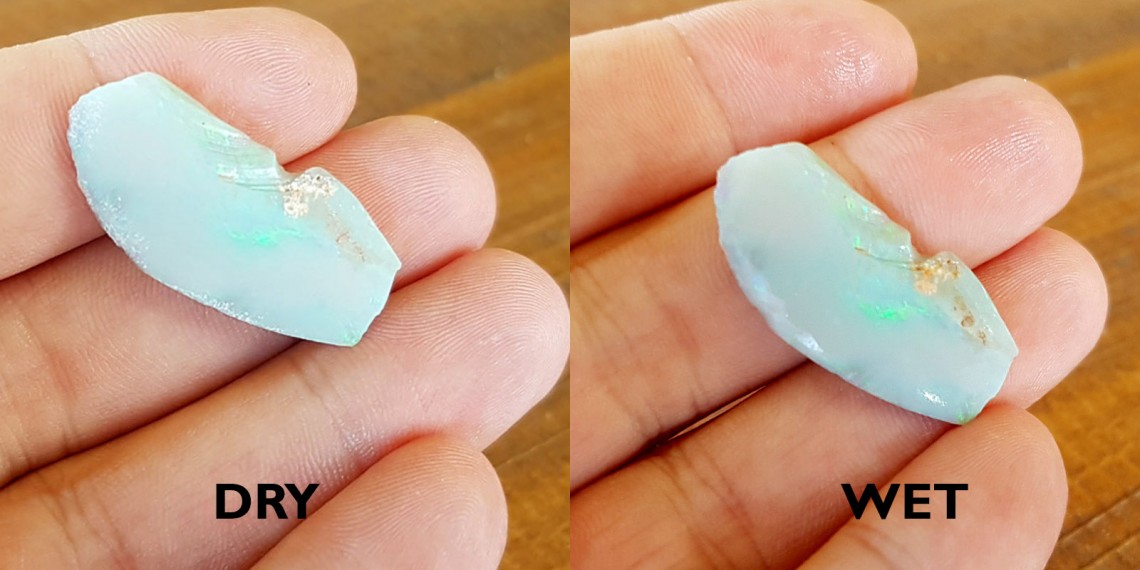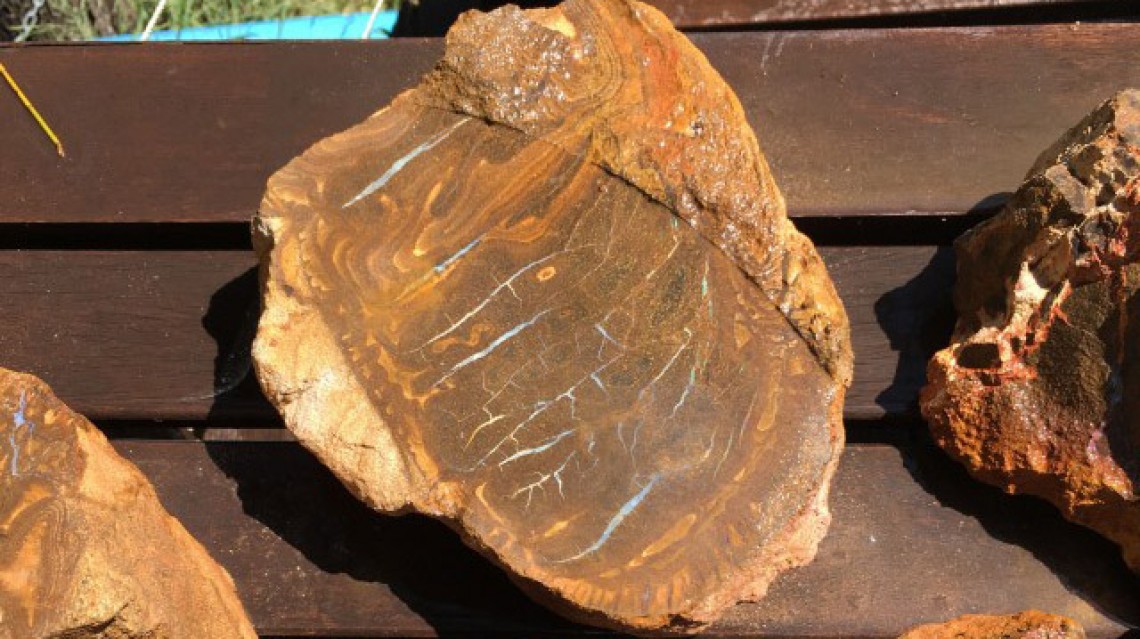
Veröffentlicht am 13th Apr 2020
Geändert am 17th Nov 2025
Warum wird Opalrohstein immer nass dargestellt?
 Ist Ihnen schon einmal aufgefallen, dass alle Rohopale, die auf Opal Auctions angeboten werden, nass sind? Haben Sie sich jemals gefragt, warum? Manche vermuten, es handle sich um Betrug oder das Wasser diene der Farbverbesserung. Wir können Ihnen versichern, dass dem nicht so ist. Lassen Sie uns der Sache nachgehen.
Ist Ihnen schon einmal aufgefallen, dass alle Rohopale, die auf Opal Auctions angeboten werden, nass sind? Haben Sie sich jemals gefragt, warum? Manche vermuten, es handle sich um Betrug oder das Wasser diene der Farbverbesserung. Wir können Ihnen versichern, dass dem nicht so ist. Lassen Sie uns der Sache nachgehen.
Rohopal auf den Opalfeldern
In den australischen Opalminen ist es üblich, dass Opalgräber sich gegenseitig ihre Rohfunde zeigen. Frisch geförderte Opale weisen noch nicht das typische Farbenspiel auf, das wir kennen. Der Grund dafür ist, dass wir bei einem Opal meist an das geschliffene Endprodukt denken. Erst durch das Polieren kommt das Farbenspiel des Opals richtig zur Geltung.

Da der Opal rau, staubig und trocken ist, kann man seine Farbe nicht erkennen. Deshalb standen die Minenarbeiter in Gruppen zusammen und leckten jeweils ihren Opal ab, um die Farbe sichtbar zu machen. Durch das Ablecken wurde die wahre Farbe des Opals enthüllt und man konnte erahnen, wie er nach dem Schleifen und Polieren aussehen würde. Anschließend ließen die Minenarbeiter die Opale herumgehen, damit jeder seine Zustimmung geben oder Kommentare abgeben konnte.
Man kann sich vorstellen, wie sich Grippe und Erkältungen auf den Campingplätzen ausbreiteten. Im Winter erkrankten die meisten Opalgräber. Auch im Verkaufsbereich der Stadt leckten die Opalverkäufer ihre Opale ab, um die Farbe sichtbar zu machen. Sogar die Käufer fassten die Opale an und leckten sie dann ab, um die Farbe deutlich zu sehen.

Leider ist das Ablecken oder Bespucken des Rohopals in den Opalabbaugebieten auch heute noch üblich. Ein Käufer kaufte sich eine kleine Sprühflasche, um den Rohopal vorher zu besprühen, anstatt ihn abzulecken. Das ist eine deutlich hygienischere Methode, die Farbe des Opals zu prüfen.
Die Opalparzellen werden normalerweise in Eimern mit Wasser herumgetragen, damit man die Opale leicht begutachten und bewerten kann.
Rohopal aus Queensland
Die Opalvorkommen in Queensland bieten auch mit Wasser besprühte Rohopale an. Der Opal aus Queensland unterscheidet sich jedoch stark von Opalen aus anderen Regionen, da er in Eisenerz eingebettet ist. Ein erfahrener Käufer orientiert sich an der Farbader des Opals, um dessen Lage zu bestimmen; Wasser allein hilft dabei wenig. Solange die Farbader nicht sichtbar ist, lässt sich der Wert des Steins nur schwer einschätzen.

Äthiopischer Opal-Rohling
Äthiopischer Rohopal wird auch im nassen Zustand angeboten. Da es sich um einen Hydrophanopal handelt, kann er seine Farbe verändern, wenn er Wasser aufnimmt. Hydrophanopal kann im nassen und trockenen Zustand unterschiedliche Helligkeit und Muster aufweisen. Dies hängt auch von der Temperatur und Luftfeuchtigkeit am Lagerort ab. Wir empfehlen stets, äthiopischen Rohopal vor dem Schleifen sowohl im warmen als auch im kalten Zustand zu testen, um eventuelle Risse gezielt zu entfernen. Im Zweifelsfall bitten Sie den Verkäufer um ein Foto des trockenen Opals und lassen Sie ihn über Nacht trocknen.
Rohopal auf Opalauktionen
Unser Verkäufer hat die Erlaubnis, Bilder von nassem Rohopal zu veröffentlichen, um Käufern die Farbe besser zu veranschaulichen. Würde der Opal trocken abgebildet, wäre die Farbe für den Käufer kaum sichtbar. Wir weisen außerdem darauf hin, dass einige Käufer nach Erhalt des Rohopals bemängeln, dass dieser nicht den Abbildungen entspricht. Dies liegt daran, dass der Rohopal trocken statt nass versendet wird. Im nassen Zustand entspricht er der Abbildung in der Anzeige, und nach dem Schleifen weist er dieselbe Farbe auf wie auf den Fotos des nassen Rohopals.
Opal-Rohmaterial kaufen
Suche nach Opal Encyclopedia
Verwandte Auktionen
In Verbindung stehende Artikel
Opale sind farbenprächtige Edelsteine und daher die perfekte Inspiration für Make-up! Erfahre alles über Make-up mit schwarzem Opal und wie Marken Opalfarben in ihre Produkte integrieren!
1st Sep 2020
Neue Artikel
Erfahren Sie, wie Opale bewertet werden und welche Faktoren ihren Preis beeinflussen. Von Farbe und Leuchtkraft bis hin zu Schliff und Herkunft – lernen Sie, wie die verschiedenen Opalarten bewertet werden, inklusive Preisbeispielen.
19th Jul 2023
Begeben Sie sich auf eine Reise und erfahren Sie von unserer Gastautorin Vivien Schapera von Crystal Healing Techniques mehr über die Heilkraft von Opalen!
20th May 2023
Der Opal der Flammenkönigin (auch bekannt als Feuerkönigin) ist der teuerste Opal der Welt und wurde für umgerechnet 3 Millionen US-Dollar verkauft. Erfahren Sie alles über seine Geschichte und seine besonderen Eigenschaften!
18th Feb 2023
Artikelkategorien
All there is to know about Opals including Black Opals, Ethiopian Opals & Boulder Opal
14 Artikel
Check out our fascinating information and articles on all things amazing in the Opal world
41 Artikel
Opal Auctions sellers who are approved as opal Verified Sellers
4 Artikel








![BOULDER MATRIX WIRE WRAPPED 79.15 CTS [BMA3166 ]](https://liveplatforms-production.b-cdn.net/tenants/oa/uploads/images/230000-234999/231183/231183_1275789915.jpg?width=480&aspect_ratio=1001%3A1000)